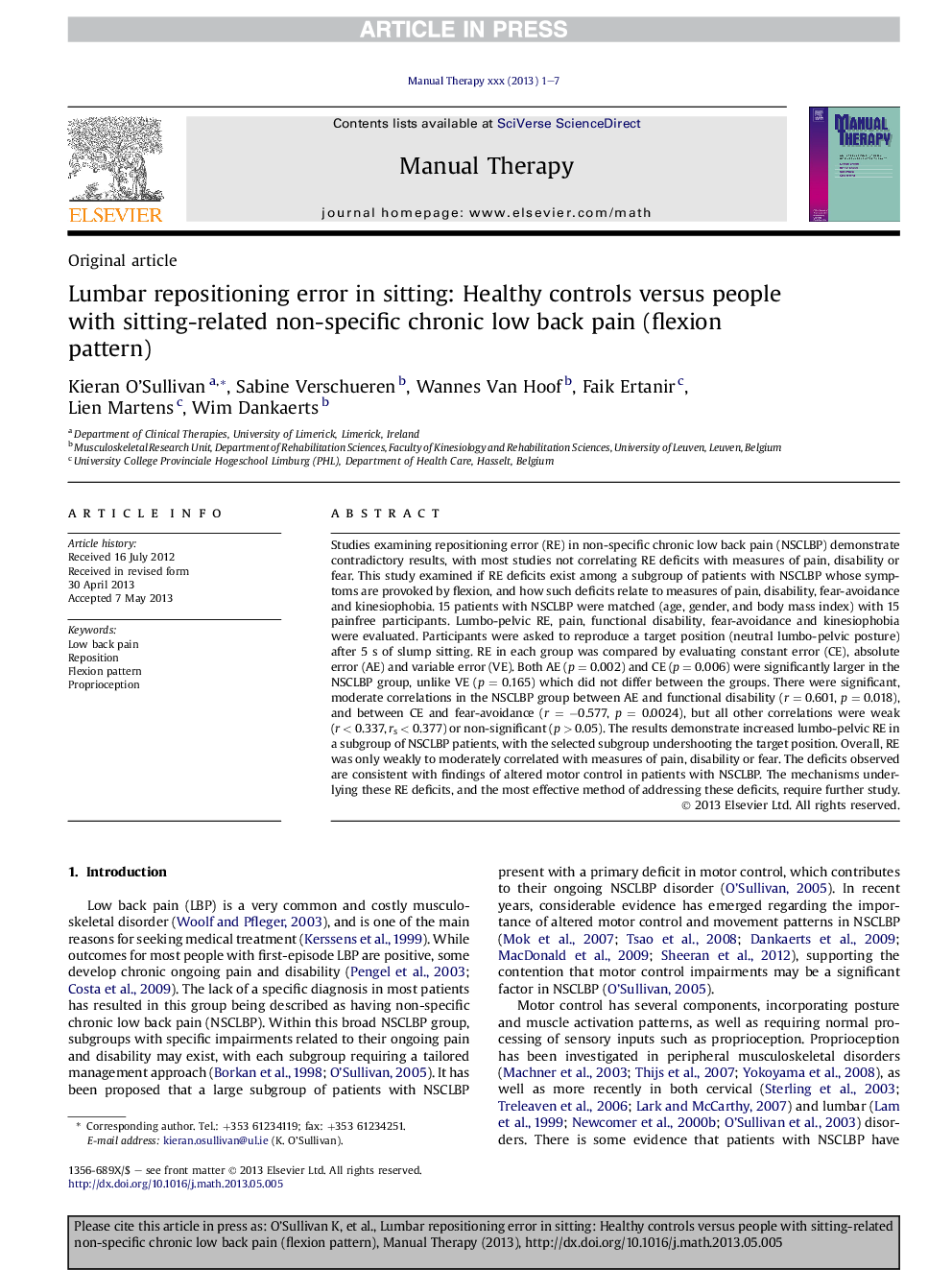| کد مقاله | کد نشریه | سال انتشار | مقاله انگلیسی | نسخه تمام متن |
|---|---|---|---|---|
| 5864845 | 1135940 | 2013 | 7 صفحه PDF | دانلود رایگان |
عنوان انگلیسی مقاله ISI
Lumbar repositioning error in sitting: Healthy controls versus people with sitting-related non-specific chronic low back pain (flexion pattern)
ترجمه فارسی عنوان
خطای تغییر موقعیتی در ناحیه نشسته: کنترل سالم در افراد مبتلا به کمردرد مزمن غیرطبیعی مرتبط با نشست (الگوی فلکسن)
دانلود مقاله + سفارش ترجمه
دانلود مقاله ISI انگلیسی
رایگان برای ایرانیان
کلمات کلیدی
کمر درد، جایگزینی، الگو انعطاف پذیر، تجارب
موضوعات مرتبط
علوم پزشکی و سلامت
پزشکی و دندانپزشکی
طب مکمل و جایگزین
چکیده انگلیسی
Studies examining repositioning error (RE) in non-specific chronic low back pain (NSCLBP) demonstrate contradictory results, with most studies not correlating RE deficits with measures of pain, disability or fear. This study examined if RE deficits exist among a subgroup of patients with NSCLBP whose symptoms are provoked by flexion, and how such deficits relate to measures of pain, disability, fear-avoidance and kinesiophobia. 15 patients with NSCLBP were matched (age, gender, and body mass index) with 15 painfree participants. Lumbo-pelvic RE, pain, functional disability, fear-avoidance and kinesiophobia were evaluated. Participants were asked to reproduce a target position (neutral lumbo-pelvic posture) after 5 s of slump sitting. RE in each group was compared by evaluating constant error (CE), absolute error (AE) and variable error (VE). Both AE (p = 0.002) and CE (p = 0.006) were significantly larger in the NSCLBP group, unlike VE (p = 0.165) which did not differ between the groups. There were significant, moderate correlations in the NSCLBP group between AE and functional disability (r = 0.601, p = 0.018), and between CE and fear-avoidance (r = â0.577, p = 0.0024), but all other correlations were weak (r < 0.337, rs < 0.377) or non-significant (p > 0.05). The results demonstrate increased lumbo-pelvic RE in a subgroup of NSCLBP patients, with the selected subgroup undershooting the target position. Overall, RE was only weakly to moderately correlated with measures of pain, disability or fear. The deficits observed are consistent with findings of altered motor control in patients with NSCLBP. The mechanisms underlying these RE deficits, and the most effective method of addressing these deficits, require further study.
ناشر
Database: Elsevier - ScienceDirect (ساینس دایرکت)
Journal: Manual Therapy - Volume 18, Issue 6, December 2013, Pages 526-532
Journal: Manual Therapy - Volume 18, Issue 6, December 2013, Pages 526-532
نویسندگان
Kieran O'Sullivan, Sabine Verschueren, Wannes Van Hoof, Faik Ertanir, Lien Martens, Wim Dankaerts,
